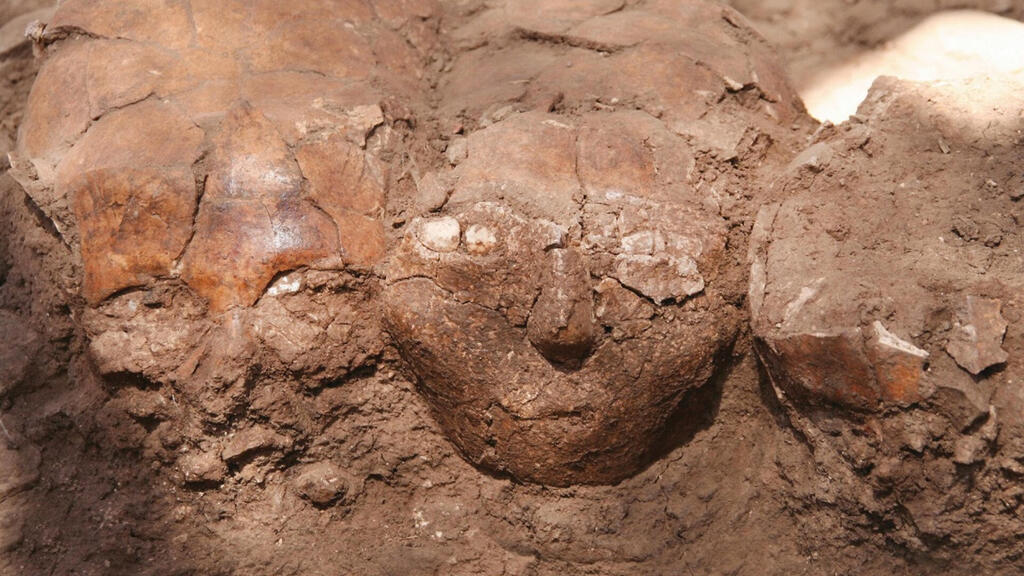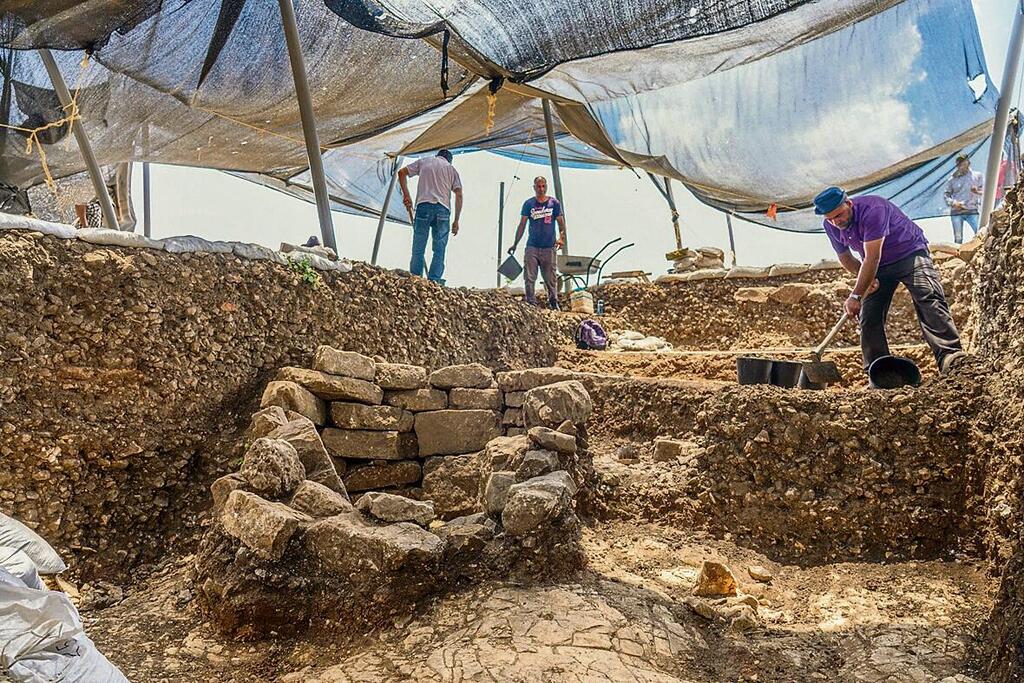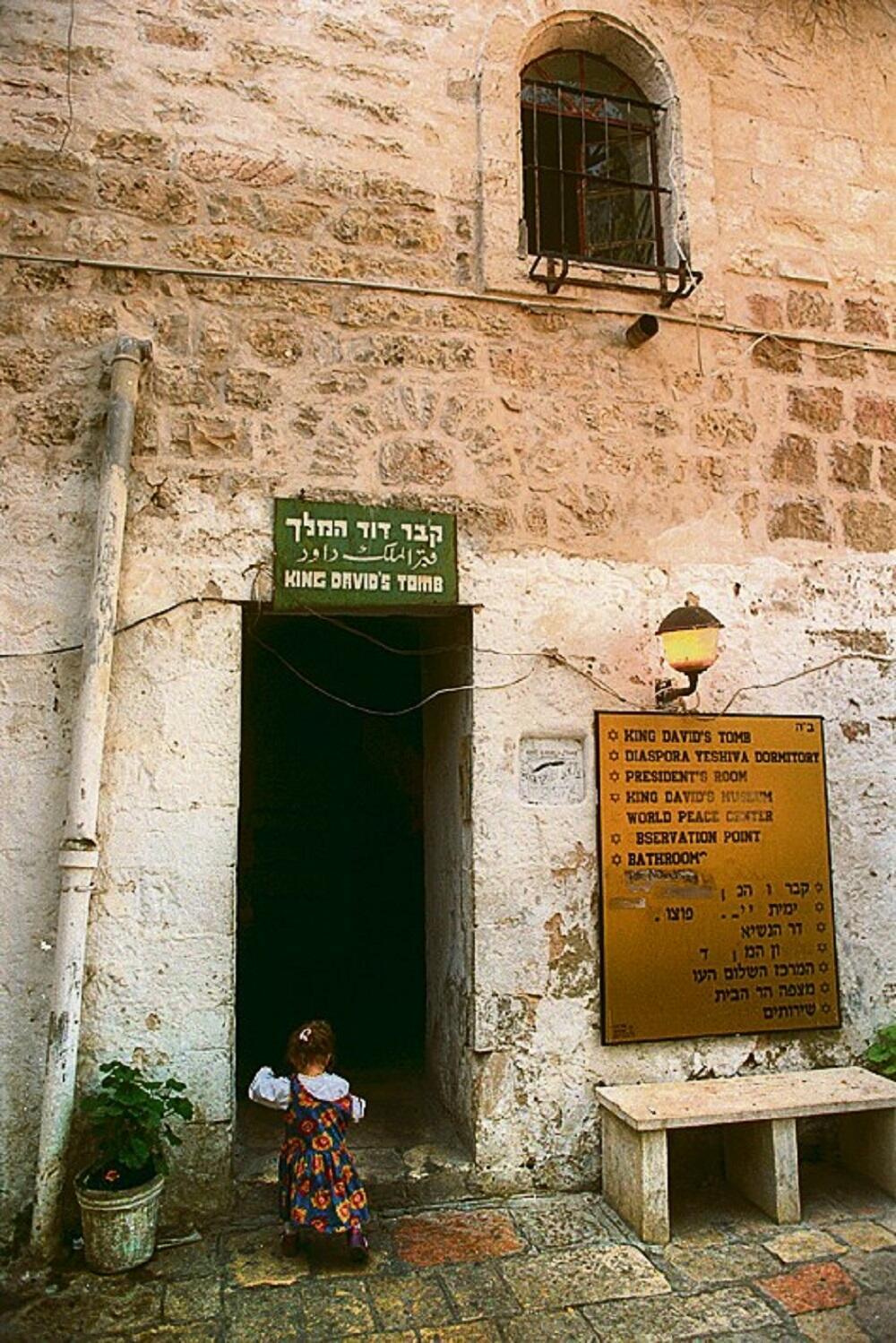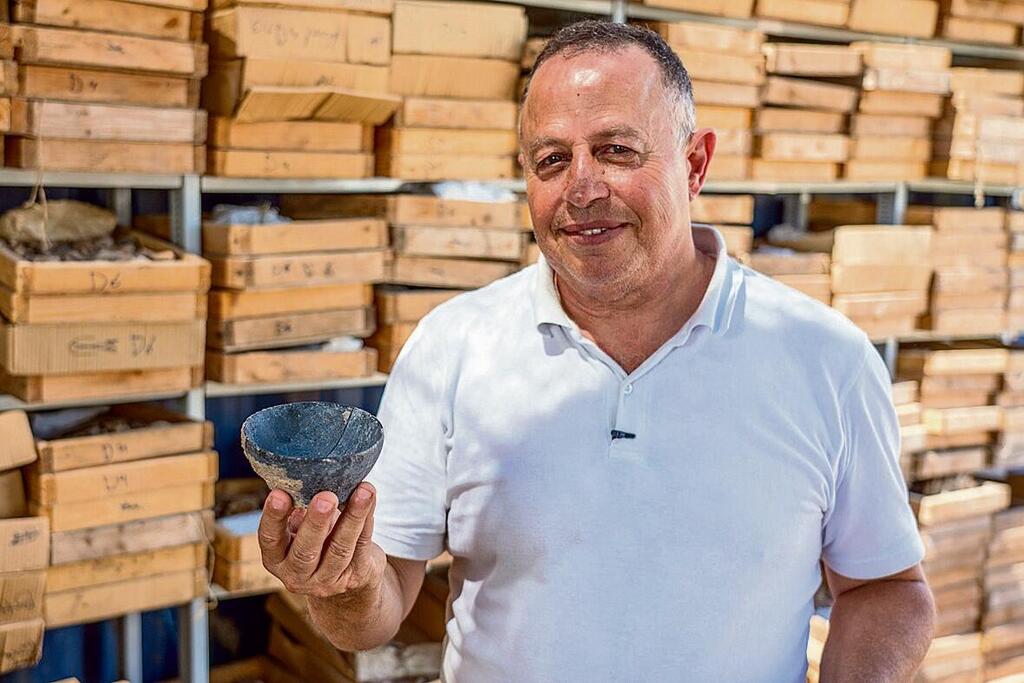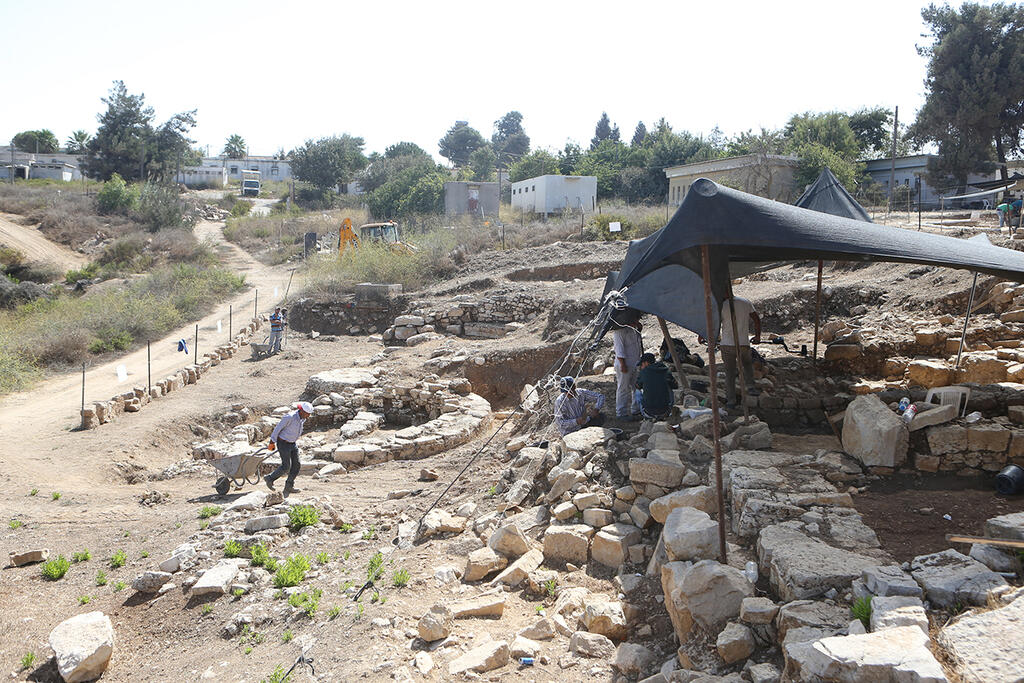In the 1980s, Dr. Hamoudi Khalaily was a young archaeologist who had the opportunity to assist renowned Israeli archaeologist Prof. Avraham Negev, who specialized in desert settlement and Nabatean culture. The two arrived at the Nabatean city of Halutza, not far from Be'er Sheva, and settled near an impressive Nabatean mausoleum.
More stories:
That day, which began as an exciting professional challenge for the young archaeologist, ended with a story that sounded like it was taken directly from an Indiana Jones movie.
"We started excavating the mausoleum to see who was buried there," Dr. Khalaily recounts. "I was working, and Avraham Negev was there overseeing the dig and explaining how I should work. I dug about two meters deep until I found stone slabs, when I began smelling a foul odor rising from the ground. I looked at Negev from below and told him about the smell. He replied saying it was a smell well known in Nabatean sites.”
“I told myself I shouldn’t question my professor as a young student, then I lifted a slab, and saw a human hand in front of me. I screamed. I looked up and saw Prof. Negev starting to run in fear toward the wadi because of my scream."
What was going through your mind at that moment?
"I thought it was a Nabatean hand, or that someone else had used a grave that had already been dug there to bury someone. The hand was relatively fresh and couldn’t have been there for a long time. It was clear this was a body.”
The missing body
The two reported their discovery to the police, and the next day a forensic team arrived to extract the body from the pit. To their utmost surprise, they found nothing where they had previously dug. "To this day, it's not clear where the body disappeared to. We stood there dumbfounded because the body was gone. But I found wraps there, and I swear they were new. I didn't have the tools to ask questions back then; I just asked them to leave alone and stop doubting whether I was sane.”
This story, which could have been laughed off as a humorous anecdote from the early days of a novice archaeologist, was only the first in a series of peculiar events that Dr. Khalaily encountered in the course of his professional career.
A panel at an upcoming storytelling festival in Sukkot, in collaboration with the Israel Antiquities Authority (IAA) will be dedicated to archaeology. During the panel, Dr. Khalaily, a seasoned researcher in the field of prehistory who manages major excavation projects for the IAA, will share stories that occurred during his work at historical sites for which no rational explanations were found.
"These are bizarre occurrences that can’t be explained through our knowledge or science, and some of them border on fiction. But these things happened. We’re all educated in our fields, but still can’t find an answer. A regular person might think it's a hoax or that I was imagining things. But these things happened. They just couldn’t be explained rationally."
The mysterious phantom
An event that Dr. Khalaily has the hardest time explaining took place in 2012 at the Tomb of David complex in Jerusalem. "In 2012, a new technology was introduced which is very common today - 3D photography," he explains.
"An Italian team working at the Cyprus Institute of Archaeology came to introduce the technique in Israel. It was a device that emitted a laser beam and rotated 360 degrees both vertically and horizontally, capturing over 200 images per minute. A computer then compiled the images to create a 3D model of the subject being photographed. This tool is especially useful in archaeology, where measurements are crucial for proper documentation.”
"We took the device on several projects, one of which was at King David’s tomb in Jerusalem. The room’s interior has never been scanned in 3D, and it was interesting to create a very precise image of the room where many believe King David is buried."
What was supposed to be another routine workday led to a series of mysterious events that have remained unexplained even today. "We arrived there and set up the laser device," Dr. Khalaily recalled. "We cleared everyone from the area to ensure that no one would be harmed by the laser beams, which could potentially cause blindness. We worked, took photos, and the Italian team collected the images and created the 3D image. In this wonderful image, a figure could be seen. It had no discernible eyes, nose or mouth, but you could clearly see a figure - a body, a head, hands and legs."
What do you think happened there?
"We thought maybe someone snuck in there while the machine was working, even though everyone had left. So, we tried again and made sure the place was completely sterile. We fenced off the area, and no one was left there. We even operated the device remotely. After an hour and a half of processing the images, the figure appeared again, this time from a different angle, despite us having removed everyone.
"We were a team of eight researchers. We took three sets of photos, and it happened again and again. Since it was clear that no one had approached the photography radius, we wondered about the identity of this figure. We checked if there might be a computer bug or a problem with the device, but everything was working correctly."
As researchers from Italy were also present during the process, the mysterious story of the figure photographed in the Tomb of David reached the Vatican. "The pope ordered the tapes be confiscated, and any attempt to obtain them or convince someone this took place has been in vain. So for now, it’s a story. It’s up to you if you choose to believe it.”
“I'm telling this story with excitement and awe. I still don't know who that figure was. I'm a rational person who doesn't believe in superstitions, but it happened. Since then, they haven't photographed the place again. It's a sensitive area which makes it hard to gain approval to look into it. It was a one-time opportunity. Even my colleagues couldn’t get a permit. This story is still up in the air, and I would have loved to go to the Vatican's archives and retrieve the tapes."
Dr. Hamoudi Khalaily, 67, who lived in Jerusalem working for the IAA, is considered one of the primary archaeologists in Israel. He has a rich career spanning 35 years and has been responsible for many discoveries that shed light on ancient life in Israel.
After leading massive projects involving hundreds of people, nowadays he focuses on management, or as he puts it, "Today I'm excavating with my words. It has been a long time since these events, and they’re still etched in my mind. They’ve had a tremendous influence over me.”
The skulls that kicked up a storm
Another extraordinary event Dr. Khalaily was involved in occurred in 2008 during excavations at a site dating back around 8,000 years ago in northern Israel. "This is the time when humans abandoned nomadism and hunting-gathering, and became agriculturists. The culture we excavated had established a settlement near the Zippori National Park, which was an important water source.”
“We arrived at the site due to proposed changes at a nearby accident-prone intersection, and I was asked to come and excavate the area before works could proceed. We conducted the excavations with a fairly large team, and since it was a hot summer, we shaded the area."
Dr. Khalaily explains that the people who lived in the area thousands of years ago used to bury their deceased leaders and then recreate their likeness with a mask. "The symbolic meaning was that a person would continue to lead the community even after death, until a new leader appeared to lead in their place.
"When we exposed the upper part of the skulls, a powerful storm, the likes of which had not been documented in the area since the 1950s, blew out of nowhere. The commotion grew as shaders and equipment started flying away with the strong wind, and out of concern for the findings, I covered them with a tarp. Then the storm passed, and everything returned to normal"
"Luckily for us, my team uncovered three skulls that were found close to one another. But, when we exposed the upper part of the skulls, a powerful storm, the likes of which had not been documented in the area since the 1950s, blew out of nowhere. The commotion grew as shaders and equipment started flying away with the strong wind, and out of concern for the findings, I covered them with a tarp. Then the storm passed, and everything returned to normal. We had to gather everything and rebuild the site."
Dr. Khalaily and his team returned to the site the next day at 6:00 in the morning. "We raised the tarp, and as soon as we started digging, another storm hit. It was like a cyclone, the wind was swirling fiercely, scattering our equipment. This storm returned at least three times, calming down only when we covered the skulls. It was so strange that we decided not to dig further at that moment but to extract everything as a single piece and take it to a laboratory at Tel Aviv University."
One person who accompanied Dr. Khalaily during that event is IAA archaeologist Nimrod Getzov. "We started digging, and suddenly a small tornado hit, blowing away all our tents and equipment just as we uncovered the skulls. I'm too cynical to think there's a connection between these things, but I can't argue with the facts,” says Getzov.
Could it be you’ve disturbed the dead?
"Two types of masks on skulls exist in the local archaeology. There's the type we call 'sleepy,' with eyes closed and defined cheekbones. We've dug them up all over the country, and nothing ever happened. Then there are the masked skulls that appear as if the person is alive, with open eyes. The three skulls we found were of this type. Maybe they were sending us a message,” Dr. Khalaily said.
Is there still anywhere left to excavate in such a small country as Israel?
"Yes, Israel is small but the demand for construction means we have to excavate quickly, or we'll miss important pieces of history. We’re dealing with a history that began two million years ago and ended with the British Mandate. This land is and was important to all three major religions that inhabited it during different times in history. Due to its importance, the law requires us to go to any future construction project that might prevent us from excavating in the future. So, there's no shortage of work."


